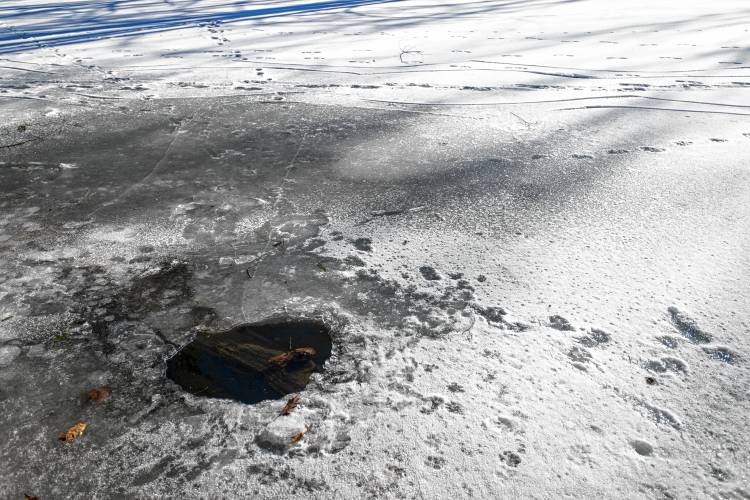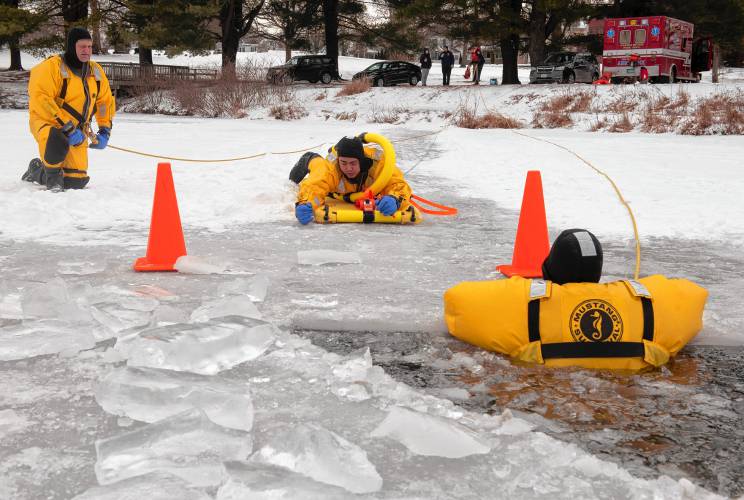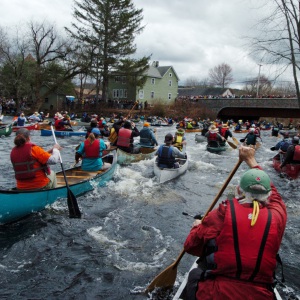Ice dangers: Safety officials urge caution while ice fanatic preaches ‘common sense’
| Published: 02-17-2025 6:02 AM |
NORTHAMPTON — Frozen lakes and ponds invite enchanted winter sports enthusiasts outside for classic wintertime festivities. But despite the fun, a fact remains: ice is a potential danger.
Days after a goldendoodle fell through the ice and could not be recovered in Northampton’s Mill River, local fire officials urged caution and reiterated standard safety measures, while local ice fanatic Tom Adams of Williamsburg encourages “common sense” when heading out onto the ice to prevent frostbite, hypothermia or worse.
The most important rule of thumb, officials said, is to never trust ice over a body of moving water — one that has a flow or current — as rivers and streams are never safe for skating or recreational activity.
Meanwhile, lakes, ponds and still bodies of water must have ice at least 4 inches thick for it to be safe for a single person to walk or ice fish on, according to official recommendations for ice safety, and anything less than 2 inches is unsafe. A thickness of 5 inches or more can support a snowmobile, and 8 to 12 inches would support as much as a car or small pickup.
Water freezes more slowly than the ground, so even following days of consistent freezing temperatures the water may not yet be solid, officials warn.
Fire Chiefs Andy Pelis of Northampton and Lindsay Stromgren of Amherst noted that local spots often attract people for their ice — spots that are often unsafe, including Mill River and Puffer’s Pond in Amherst.
Mill River, for instance, is a place that Northampton residents have reportedly seen both children and curious photographers walking on the ice, just days before the goldendoodle disappeared below the surface, according to South Street resident Elissa Alford. However, Pelis firmly said this is never a safe area, being a river and, therefore, a moving body of water.
When a person falls through the ice, their body can go into shock from the rapid change in temperature. Once a person’s core body temperature drops to 95 degrees, they officially become hypothermic, according to the U.S. Centers for Disease Control and Prevention.
Article continues after...
Yesterday's Most Read Articles
 Two arrested on drug trafficking charges in Greenfield
Two arrested on drug trafficking charges in Greenfield
 Four Red Fire Farm workers arrested as part of ICE operation in Springfield
Four Red Fire Farm workers arrested as part of ICE operation in Springfield
 Berkshire DA says no crime occurred in student-officer relationship at Mohawk Trail
Berkshire DA says no crime occurred in student-officer relationship at Mohawk Trail
 Greenfield seeks renewal of Slum and Blight designation to bring in funds for infrastructure
Greenfield seeks renewal of Slum and Blight designation to bring in funds for infrastructure
 Franklin County Technical School seniors get to try underwater welding
Franklin County Technical School seniors get to try underwater welding
 The ills of a billion-dollar enterprise: The slow-death of the cannabis industry, and what might be done to reverse the trend
The ills of a billion-dollar enterprise: The slow-death of the cannabis industry, and what might be done to reverse the trend
Stromgren said determining ice’s safety requires knowledge of inlets and discharges of natural bodies of water to help assess the thickness and durability of a sheet of ice. Stromgren said no member of his department would ever recommend a resident go on any frozen body of water — whether a moving body such as a river or stream or even a still body like a lake or pond — due to the numerous variables involved with ice safety.
Any sheet of ice, he said, is “potentially problematic.”
As a lifelong ice enthusiast, Adams said that as real as the dangers are, don’t let them keep you inside.
For him, two local places to skate, ice fish or hang out that “freeze real well” are the DAR State Forest in Goshen and the Oxbow in Easthampton and Northampton. He said there are “so many more” in western Massachusetts that are highlighted on Western Mass Ice Skaters, a Facebook page for which he serves as an administrator.
The page formed to grow a community for followers to talk about local, safe venues to skate while sharing “the fun of it all.”
Adams, who grew up as a Sabres hockey fan from New York and who now lives in Williamsburg, said, “It’s the best feeling ever being on a lake with perfectly glass ice,” but also advised ice seekers to “use common sense” by being aware of moving water, currents and other factors that can weaken ice as officials recommended.
He advises those interested in skating or traveling across ice to pack safety gear. This may include warm, layered clothing; ice picks and ice cleats; and potentially life jackets or a rope.
For Adams, there are always three things packed: an ice picker, a hockey stick for support with balancing on the ice and a whistle in the case of an emergency. He said many skaters will often wear a flotation device, too. As a seasoned skater, he shared how he is able to identify the safety of ice based on its tint.
“The ice should be a clear blue color. Color is one of the key clues to determining whether the ice will hold your weight. If it’s clear and blue, it’s likely safe,” he said. “Opaque white ice isn’t quite as strong, while gray or black indicates that there’s water present; the ice may be melting or have air pockets. Keep in mind that even if it is the ideal crystal blue, you’ll still want to always be alert.”
The state Division of Fisheries & Wildlife offers the following ice tips:
■New ice is stronger than old ice. Four inches of clear, newly formed ice may support one person on foot, while a foot or more of old, partially thawed ice may not.
■Ice doesn’t freeze uniformly. Continue to check ice conditions frequently as you venture out onto the ice.
■ Avoid traveling onto ice-bound rivers and streams, as the currents make ice thickness unpredictable. Many lakes and ponds may contain spring holes and other areas of currents that can create deceptively dangerous thin spots.
■Tell someone your plans, including where you are going and when you expect to return.
■Come prepared. Carry a cellphone in case of emergency. Always carry ice picks and rope with you on the ice. In case of emergency, drive the nails into the ice and pull yourself to safety while kicking.
■Wear your life jacket. If you fall in, a life jacket will keep you at the surface and can provide insulation against the effects of cold water.
Samuel Gelinas can be reached at sgelinas@gazettenet.com.














 Literacy Project celebrating 40 years of education
Literacy Project celebrating 40 years of education River Rat Race returns for 60th year on April 12
River Rat Race returns for 60th year on April 12 Backyard Oasis, connecting older adults with podcasts, celebrates 50 episodes
Backyard Oasis, connecting older adults with podcasts, celebrates 50 episodes Stage on Main exhibit displays Athol resident’s work through the decades
Stage on Main exhibit displays Athol resident’s work through the decades
